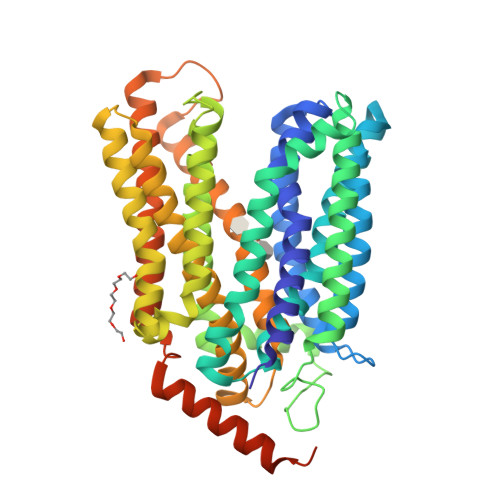Distinct roles of the major binding residues in the cation-binding pocket of the melibiose transporter MelB.
Hariharan, P., Bakhtiiari, A., Liang, R., Guan, L.(2024) J Biological Chem 300: 107427-107427
- PubMed: 38823641
- DOI: https://doi.org/10.1016/j.jbc.2024.107427
- Primary Citation of Related Structures:
8FQ9, 8FRH - PubMed Abstract:
Salmonella enterica serovar Typhimurium melibiose permease (MelB St ) is a prototype of the major facilitator superfamily (MFS) transporters, which play important roles in human health and diseases. MelB St catalyzed the symport of galactosides with Na + , Li + , or H + but prefers the coupling with Na + . Previously, we determined the structures of the inward- and outward-facing conformation of MelB St and the molecular recognition for galactoside and Na + . However, the molecular mechanisms for H + - and Na + -coupled symport remain poorly understood. In this study, we solved two x-ray crystal structures of MelB St , the cation-binding site mutants D59C at an unliganded apo-state and D55C at a ligand-bound state, and both structures display the outward-facing conformations virtually identical as published. We determined the energetic contributions of three major Na + -binding residues for the selection of Na + and H + by free energy simulations. Transport assays showed that the D55C mutant converted MelB St to a solely H + -coupled symporter, and together with the free-energy perturbation calculation, Asp59 is affirmed to be the sole protonation site of MelB St . Unexpectedly, the H + -coupled melibiose transport exhibited poor activities at greater bulky ΔpH and better activities at reversal ΔpH, supporting the novel theory of transmembrane-electrostatically localized protons and the associated membrane potential as the primary driving force for the H + -coupled symport mediated by MelB St . This integrated study of crystal structure, bioenergetics, and free energy simulations, demonstrated the distinct roles of the major binding residues in the cation-binding pocket of MelB St .
Organizational Affiliation:
Department of Cell Physiology and Molecular Biophysics, Center for Membrane Protein Research, School of Medicine, Texas Tech University Health Sciences Center, Lubbock, Texas, USA.




















